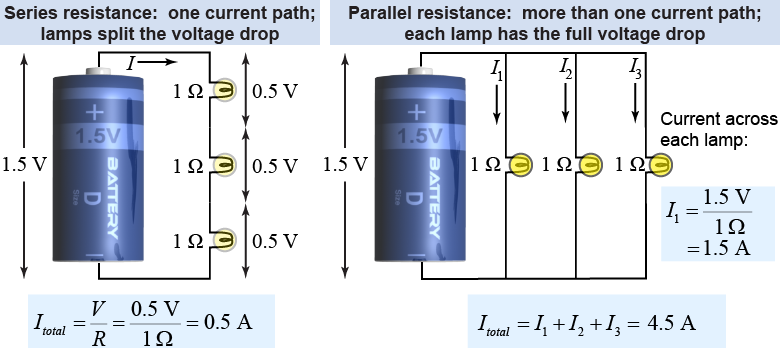|
A parallel circuit contains branches that provide more than one path for electric current to follow. In a parallel circuit each branch can have a different current flowing through it. The total current in the circuit is the sum of the individual currents flowing in each branch. 
|

|
Compare the series and parallel circuits in the diagram above. The current across a single bulb by itself would be I = (1.5 V)/(1 Ω) = 1.5 A. In the series circuit, however, the voltage across each individual resistor (0.5 V) is a fraction of the voltage across all three resistors (1.5 V). Since the same current flows through all three resistors, we can calculate the current of the circuit by calculating the current through only one resistor, or I = (0.5 V)/(1 Ω) = 0.5 A. The current in the series circuit is less than it would be if there were just one bulb. This happens because the overall resistance seen by the battery has increased: The resistances of each lamp add in series so that the total resistance is three times the resistance of a single lamp. 
|
In the parallel circuit, in contrast, each lamp has a direct low-resistance connection to both battery terminals. Because wires have negligible resistance, there are no voltage drops across the wires. Each lamp “sees” the full 1.5 V from the battery and therefore draws 1.5 A of current, as if it were the only lamp in the circuit. The total current from the battery is 4.5 A, which is the sum of the current in each of the three branches. The current in the three-bulb parallel circuit is greater than it would be in a circuit with a single bulb. In essence, the parallel circuit acts like three single-bulb circuits. 
|
Keep in mind the following two rules to understand parallel circuits: - The voltage is the same everywhere along a wire.
Voltage only changes across a circuit element, such as a resistor. Although not exactly true, this rule is a good approximation because wires have very low resistance. - The current flowing out of any branch point, or junction, in the circuit must equal the current flowing into the branch point.
This rule is known as Kirchhoff’s current law. In the parallel circuit shown there are three branches, and Kirchhoff’s current law tells us that the current flowing out of the battery must equal the sum of the currents in each of the three branches. 
A circuit contains two equal resistances in parallel. Will the total current increase, decrease, or stay the same if an extra parallel branch of equal resistance is added?
 |
The total current will increase. Adding another resistor in parallel draws additional current equal to the current drawn through each of the original resistances. 
|
|
| |
|

